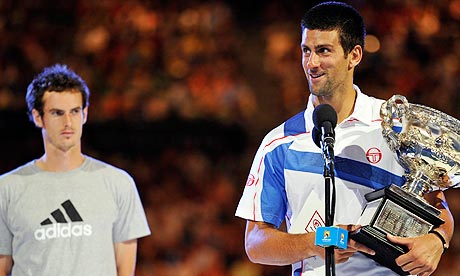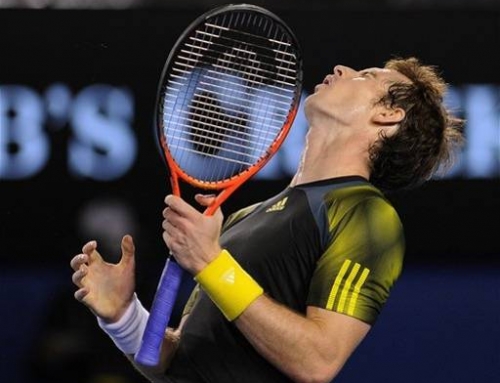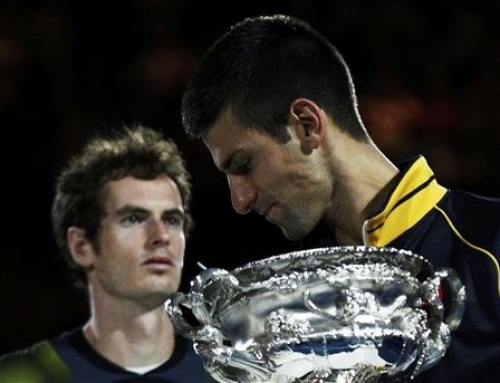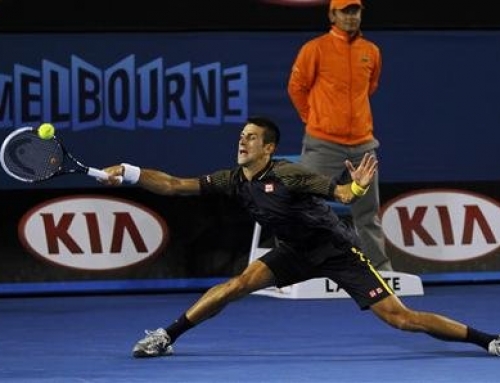 It was last year after a semifinal win over Jo-Wilfried Tsonga during a post-match interview with Jim Courier that Roger Federer said “I know he’d like to win a first for British tennis in, what is it? 150,000 years?”. It was a light-hearted moment that was, nonetheless, a dig at his opponent, one that he would beat in straight sets.
It was last year after a semifinal win over Jo-Wilfried Tsonga during a post-match interview with Jim Courier that Roger Federer said “I know he’d like to win a first for British tennis in, what is it? 150,000 years?”. It was a light-hearted moment that was, nonetheless, a dig at his opponent, one that he would beat in straight sets.
Looks like it might be 150,001 years for British tennis. Or at least, until sometime later this year.
Andy Murray started the finals, last year, with the idea that he could goad Federer into mistakes. He hit plenty of shots to the Federer backhand, only to discover that Federer was rock-solid steady.
Murray wouldn’t change tactics much until the third set where he went after Federer more, playing far more aggressive tennis. He kept even in the third set until a tiebreak that went on and on. Murray had chances to force a fourth set, but couldn’t hit the biggest shots at the biggest moments. When Roger seized the third set tiebreak, it was all Murray could do to suppress the disappointment he felt. Indeed, he couldn’t bottle up it up and shed tears during his post-match speech.
Later in the year, Murray would use a hard-hitting style to beat both Federer and Nadal at Toronto and to beat Federer at Shanghai. While Murray might have been able to outsteady Federer, it turns out Federer doesn’t play such great defense. He’s no, shall we say, Novak Djokovic. Instead, he’ll try to go toe-to-toe with you, and if he’s off his game, one has a chance to beat him. Of course, it helps to be fast, like Andy Murray. Speed is an issue for players like Soderling who has a tough time tracking down aggressive Federer shots.
Quite oddly, Murray decided to employ a similar strategy this year as he did with Federer last year, but for a different reason. Novak Djokovic had just played two big hitters in Roger Federer and Tomas Berdych. Hitting big is not Murray’s style. It’s hard for Murray to come up with big shot after big shot. Murray went after a different strategy. He decided to play lots of balls up the middle. The hope was to tire Djokovic out and force him to go for big shots at inopportune moments..
Murray was already in a bit of trouble in his second service game that just went on and on and on. Murray eventually held, but it didn’t speak well of a quick start. Murray didn’t choose to come to net very much, and alas, his first serve percentage, once again, was below 50%. Murray often wins when his first serve is abysmally low, but usually his percentage of points won on second serves is similarly low, so his opponents get a chance to try to break. With a returned as good as Djokovic, this ultimately hurt him.
But what Murray more was his inability to make a dent in Djokovic’s serve the first set that spelled the biggest difference. Djokovic kept his first serve percentage very high, nearly 70% for the first set. Both players won the vast majority of first serves: Djokovic won 94% of first serves while Murray won 81%. However, both won about half their second serves. With Murray hitting so many more second serves, it was a matter of time before it did him in, and it did when Djokovic broke Murray to take the first set, 6-4.
From that point on, Murray tried to play a bit looser. In the first set, Murray had been irritated with his eyes, constantly blinking. He also was unhappy with his racquets. The weather was expected to be warm, and it wasn’t nearly as warm as Murray had hoped. Early in the first set, he asked for racquets to be restrung, but they weren’t ready until late in the set, and it didn’t seem to matter much anyway.
With Murray playing so many shots up the middle, it appeared to make him tentative going for big shots. As Murray tried opening up the court more, this also opened up more angles for Djokovic to use in response. Furthermore, Murray was also making a ton of errors. As he went for big shots, he has hitting them wide or in the net. Some of it was Djokovic’s doing. Djokovic would start to play aggressive shots down the line while Murray would block it back (because he was standing in closer to the baseline) and hit the ball just a little deep or just a little wide.
Djokovic kept rolling to a one break lead, then a two break lead. Finally, Murray managed to break down 5-0. But it wasn’t enough as Djokovic held serve to win the second set, 6-2. Murray’s first serve percentage went up to 53%, but he was only winning 63% of his first serves, and a dismal 14% on his second serves. Djokovic was not nearly as dominant on his first serve either. He won “only” winning 75% of his first serves and 50% of his second. Obviously, still dominant numbers.
In the third set, Murray’s first serve percentage climbed up to 60%, but the tradeoff was only winning 50% of his first serves. Murray appears to be dealing with the Chang dilemma. Although Murray is some 7 inches taller than Michael Chang, Chang decided, at some point, his first serve was not powerful enough. He worked to hit harder first serves. And yet, he couldn’t do so without hitting a low first serve percentage. Murray can either go for huge first serves, and then win a free points off it, but be mired around 45% first serves, or he can try to hit about 60% first serves and then make his first serve as vulnerable as his second.
One reason Djokovic played well is that he kept his first serve percentage high and his winning percentage off his first serves high. Murray was unable to do either, which says as much about Djokovic’s return game as it does about Murray’s usual play.
At the end of the second set, Murray tried to go back to his original strategy, playing shots up the middle, but he would find Djokovic being more opportunistic and going for a big shot when it presented itself, where he was tentative in the first set and was likely to just extend the rallies. This forced Murray to go for bigger shots somewhat sooner than he wanted. At 15-30, down 5-2, Murray hit a huge forehand, but Djokovic tossed a high lob and the rally went for another 8 shots before Murray went for the winner up the line. At 30-all, Murray hit a big first serve with no return.
At 40-30, Murray hit a big shot into the net after only a 3 shot rally. At deuce, Murray went for a big forehand, and Djokovic came back with a bigger crosscourt forehand. Murray hit the reply to the middle of the court, and Djokovic pounced with a backhand to the other corner for the winner. At ad-out, Djokovic hit a big shot down-the-line to Murray’s backhand which Murray sent up the middle, then Djokovic went to the forehand corner, and Murray netted the shot to lose serve and the set.
Djokovic’s affinity for the down-the-line shot plus his ability to hit a big shot after Murray hit a hard crosscourt forehand meant Murray was in huge trouble. Djokovic never feels like he’s belting the ball super-hard. It always seems like he’s in good control. And the ball is struck plenty hard. It’s a little like Nadal, who hits hard balls, but allows you to reach the ball, without doing much about it. We’re used to seeing untouched winners from Federer, but Nadal introduced the idea of a near-winner. It doesn’t matter if you hit a big shot that the other guy gets to as long as he hits a weak reply.
In the third set, Murray again increased the level of his aggression. But at this point, the Djokovic that beat Federer showed up. As Murray tried going for big shot after big shot, Djokovic created a wall, that included slice forehands up deep. And this meant Murray had to get back to neutral in a point he thought he was winning.
Murray got plenty of breaks, but so did Djokovic. Frankly, Djokovic’s first serve winning percentage dipped to 50%, but his second serve winning percentage was 78%. And Djokovic was winning more than half the points while receiving.
Although many observers would point to Murray’s lack of aggression as the reason he lost, Murray walks a fine line. Few people think what happens when you start missing being aggressive. Lendl once figured out a formula to beat Jimmy Connors. Instead of trying to outhit Connors, he would dink the ball, over and over again. Connors is an incredibly steady guy for a flat player. However, without topspin, he will eventually miss, often 20 shots into a rally. That’s a long time, but Lendl could hit 30-40 shots if he had to.
After being on the losing end of this strategy for many times, Connors said “I’d rather win playing like a man than lose playing like a woman”. Despite two women being hugely influential to his life and his tennis, Connors saw himself as a man’s man. That aggressive mindset prevented him from winning, although it meshed with the way Connors played.
On the other hand, Murray is not naturally aggressive. He lacks the topspin safety that Djokovic or Nadal has to play aggressive shots. Murray can hit a huge shot, but he’s not used to hitting 3, 4, 5 of them in a row to win a point. He expects the first big shot to pay instant dividends. And Djokovic forced Murray to hit additional shots that he wasn’t prepared to hit.
Credit Murray with trying another strategy in the third set, but while it lead to some good things (a few breaks of serve), he was also vulnerable on his own serve.
Murray has improved quite a lot, but one key part of his game that has never quite improved is his second serve. Djokovic consistently served 10 mph faster than he had before.
Djokovic eventually closed out the match: 6-4, 6-2, 6-3. Murray was cranky throughout, telling his box to keep quiet. He managed to keep the tears away despite a cracking voice.
Djokovic revealed something in his post-match interview. Djokovic said that he had been going through some personal issues. He wouldn’t get into details, but he felt that his off-court issues was affecting his on-court performance, and that he has those issues under much better control and that is reflecting itself in better performance on court.
So Djokovic moves out of the one-Slam wonders that still has Andy Roddick in its grip and is unlikely to change for Roddick. It also leaves Murray still Slamless. There have been players that have struggled to win their first Slam. Kim Clijsters lost her first four Slams. Lendl also lost his first 4 Slam finals, and barely won the 1984 French Open, the lost his next 2 Slam finals for a 1-6 record in his first 7 Slams. But he was such a powerful player that he kept getting to Slam finals, so it was only a matter of time before he would win a few more.
This would almost be like Nadal getting to final after final, but losing. A guy as talented as Nadal would eventually break through. Murray isn’t a dominant player that imposes his game.
So Djokovic has to feel that his game is coming together and that his chances are good to move, say, to number 2.
Right now, Federer has 9245 points. Djokovic has 6240 points. Federer has a 3005 point lead on Djokovic as of the start of the tournament.
Djokovic had 360 points in his quarterfinal loss and will gain 1640 points with his win. Federer had 2000 points last year with his win and will lose 1280 points for his semifinal loss. That is a net of 2920 points that Djokovic will gain on Federer, and he will merely 85 points behind Roger Federer.
Where does this leave everyone?
Rafa Nadal will be trying to get on the mend. He is expected to play Davis Cup against Belgium, but frankly, they could put a B team against Belgium. Rafa might want the practice assuming it takes him a few weeks to heal.
Murray is scheduled to play the two tournaments he played in 2009: Rotterdam in a little over a week and Dubai. Last year, he scheduled to play Marseille, but skipped it last year, then half-heartedly played Dubai. In the post-match interview, Murray said he felt better than last year, but he was unsure how soon he’d feel like playing again.
Roger Federer usually doesn’t play again until Dubai and that’s his schedule again this year.
Like Murray, Djokovic is also scheduled to play Rotterdam and Dubai. So the two could face each other quite soon.
So what does Murray need to do? He’s got a strategy to play Federer and Nadal. Mostly, go for big shots all the time. This was a rethink on Murray’s part. At one point, he beat Federer by simply being steadier than him. The Nadal strategy hasn’t changed much only because everyone plays Nadal that way. Nadal does a better job than anyone taking a neutral ball and making you play a defensive shot. He’ll need to figure out how he wants to play Djokovic who will let Murray hit a few balls, but is also looking to hit bigger shots. Unlike Nadal or Federer, Djokovic is content not running around his backhand, which means he doesn’t leave the court nearly as open as those two.
As Djokovic continues a few months of feeling good, with the Davis Cup win and the Australian Open title, Murray must go back to the drawing board and figure out what he wants to do. Last year, at this time, I said Murray had to go and improve this and that in his game. Murray, instead, moped around for about 4 months and didn’t start recovering until about Rome. He had a decently good Indian Wells, but was upset that he lost to Soderling (he might have recovered sooner if he won Indian Wells).
And so the first Slam of the year is over, and it’s already asked questions of many of the top players. Will 2011 be the year that the top of the ranks get a first major shakeup? We shall see!






![[Aussie Open Final] Can Andy Murray beat Novak Djokovic?](https://www.essentialtennis.com/wp-content/uploads/2013/01/20130126andy-500x383.jpg)
![[Day 13, Aussie Open] Bryan brothers win 13th Slam with Aussie doubles title, Kyrgios wins boys title](https://www.essentialtennis.com/wp-content/uploads/2013/01/20130125bryan-500x383.jpg)